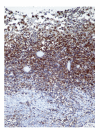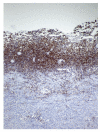Xanthogranulomatous endometritis: a challenging imitator of endometrial carcinoma
- PMID: 17710239
- PMCID: PMC1939916
- DOI: 10.1155/2007/34763
Xanthogranulomatous endometritis: a challenging imitator of endometrial carcinoma
Abstract
Xanthogranulomatous inflammation is a distinguished histopathological entity affecting several organs, predominantly the kidney and gallbladder. So far, only a small number of cases of xanthogranulomatous inflammation occurring in female genital tract have been described, most frequently affecting the endometrium and histologically characterized by replacement of endometrium by xanthogranulomatous inflammation composed of abundant foamy histiocytes, siderophages, giant cells, fibrosis, calcification and accompanying polymorphonuclear leucocytes, plasma cells and lymphocytes of polyclonal origin. We present a case of a 69-year-old female complained of post menopausal bleeding and weight loss. Clinical preliminary diagnoses were endometrial carcinoma or hyperplasia and ultrasound was supposed to be endometrial malignancy, hyperplasia or pyometra by radiologist. Histopathological examination of uterus revealed xanthogranulomatous endometritis. Since xanthogranulomatous endometritis may mimic endometrial malignancy clinically and pathologically as a result of the replacement of the endometrium and occasionally invasion of the myometrium by friable yellowish tissue composed of histiocytes, knowledge of this unusual inflammatory disease is needed for both clinicians and pathologists.
Figures




Similar articles
-
Xanthogranulomatous endometritis associated with endometrial carcinoma.Arch Pathol Lab Med. 1985 Jan;109(1):73-5. Arch Pathol Lab Med. 1985. PMID: 3838238
-
Xanthogranulomatous endometritis. Report of six cases and a proposed mechanism of development.Arch Pathol Lab Med. 1990 Sep;114(9):929-32. Arch Pathol Lab Med. 1990. PMID: 2390008
-
Lethal outcome in xanthogranulomatous endometritis.APMIS. 2006 May;114(5):386-8. doi: 10.1111/j.1600-0463.2006.apm_281.x. APMIS. 2006. PMID: 16725016
-
Canine pyometra.Theriogenology. 2006 Aug;66(3):610-2. doi: 10.1016/j.theriogenology.2006.04.023. Epub 2006 Jul 7. Theriogenology. 2006. PMID: 16828152 Review.
-
Chronic endometritis: a combined histopathologic and clinical review of cases from 2002 to 2007.Int J Gynecol Pathol. 2010 Jan;29(1):44-50. doi: 10.1097/PGP.0b013e3181ae81bb. Int J Gynecol Pathol. 2010. PMID: 19952932 Review.
Cited by
-
Transcriptome, Spliceosome and Editome Expression Patterns of the Porcine Endometrium in Response to a Single Subclinical Dose of Salmonella Enteritidis Lipopolysaccharide.Int J Mol Sci. 2020 Jun 13;21(12):4217. doi: 10.3390/ijms21124217. Int J Mol Sci. 2020. PMID: 32545766 Free PMC article.
-
Xanthogranulomatous endometritis.Facts Views Vis Obgyn. 2023 Dec;15(4):351-353. doi: 10.52054/FVVO.15.4.106. Facts Views Vis Obgyn. 2023. PMID: 38128093 Free PMC article.
-
Xanthogranulomatous endometritis with unilateral salpingo-oophoritis in a postmenopausal woman masquerading as a malignancy.BMJ Case Rep. 2023 Jan 19;16(1):e247341. doi: 10.1136/bcr-2021-247341. BMJ Case Rep. 2023. PMID: 36657821 Free PMC article.
-
Xanthogranulomatous Endometritis: A Benign Uncommon Masquerader of Malignancy.J Midlife Health. 2019 Oct-Dec;10(4):206-208. doi: 10.4103/jmh.JMH_6_18. J Midlife Health. 2019. PMID: 31942158 Free PMC article.
-
Recurrent pyometra coupled with xanthogranulomatous endometritis mimicking pyelonephritis and malignancy: unravelling clinical complexities.BMJ Case Rep. 2025 May 5;18(5):e259441. doi: 10.1136/bcr-2023-259441. BMJ Case Rep. 2025. PMID: 40324942 Free PMC article.
References
-
- Pounder DJ, Iyer PV. Xanthogranulomatous endometritis associated with endometrial carcinoma. Archives of Pathology and Laboratory Medicine. 1985;109(1):73–75. - PubMed
-
- Russack V, Lammers RJ. Xanthogranulomatous endometritis. Report of six cases and a proposed mechanism of development. Archives of Pathology and Laboratory Medicine. 1990;114(9):929–932. - PubMed
-
- Ashkenazy M, Lancet M, Borenstein R, Czernobilsky B. Endometrial foam cells. Non-estrogenic and estrogenic. Acta Obstetricia et Gynecologica Scandinavica. 1983;62(3):193–197. - PubMed
-
- Barua R, Krikland JA, Petrucco OM. Xanthogranulomatous endometritis: case report. Pathology. 1978;10(2):161–164. - PubMed
-
- Noack F, Briese J, Stellmacher F, Hornung D, Horny H-P. Lethal outcome in xanthogranulomatous endometritis. APMIS. 2006;114(5):386–388. - PubMed
Publication types
MeSH terms
LinkOut - more resources
Full Text Sources
Medical

